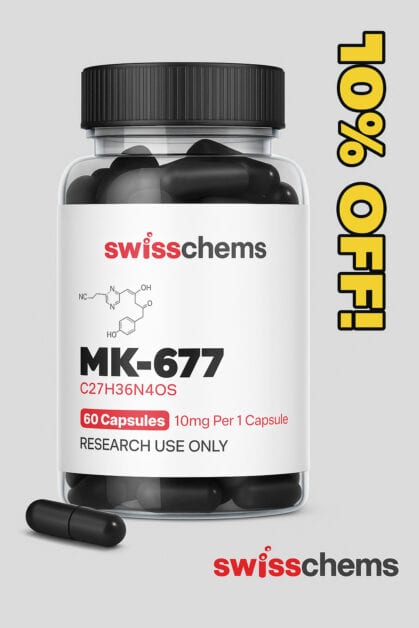Retatrutide for Fat Loss & Metabolic Enhancement – The Most Powerful GLP Yet?
If semaglutide and tirzepatide changed the game, retatrutide is rewriting the rules. Dubbed the “triple threat” in metabolic medicine, retatrutide is a triple agonist—activating GLP-1, GIP, and glucagon receptors—to deliver unprecedented weight loss, fat oxidation, and metabolic resilience.
This in-depth guide explores:
- What retatrutide is and how it works at a biochemical level
- A detailed comparison: Retatrutide vs Semaglutide vs Tirzepatide
- Clinical trial data, interpretation, and what it means for lifters
- Dosing strategies, timing, and real-world applications
- Where it fits in bodybuilding, TRT, and physique enhancement
What Is Retatrutide?
Retatrutide (development code: LY3437943) is a next-generation peptide drug created by Eli Lilly. It is designed as a once-weekly injectable triple receptor agonist. Retatrutide is a triple receptor agonist that activates GLP-1, GIP, and the glucagon receptor, producing exceptionally large mean weight loss in controlled trials, including signals near 17.5 percent at 24 weeks, and roughly 23 to 24 percent at 48 weeks for the highest dose arms. The efficacy is striking, but tolerability and long term safety require further study, and real world misuse is an active concern.
Retatrutide (LY3437943) is a single molecule that engages three hormonal pathways related to appetite, energy balance, and metabolism. GLP-1 reduces appetite and slows gastric emptying, GIP modulates insulin and may alter energy partitioning, and glucagon receptor activation can increase energy expenditure. The combined activity produces both strong suppression of caloric intake and a rise in calorie burn, which explains the larger total weight loss observed in trials compared with many earlier agents.
- GLP-1 receptor (glucagon-like peptide-1): Best known for appetite suppression and improved insulin secretion.
- GIP receptor (glucose-dependent insulinotropic peptide): Enhances insulin response and may contribute to improved lipid metabolism.
- Glucagon receptor: Promotes thermogenesis and fat oxidation.
Unlike monotherapy approaches like semaglutide (Ozempic) or even dual therapies like tirzepatide (Mounjaro), retatrutide activates all three metabolic levers for a synergistic impact on weight loss and energy expenditure.
“This is the most advanced therapeutic peptide for metabolic disease to date.” — New England Journal of Medicine, 2023
Mechanism of Action: The Power of Triple Agonism
GLP-1 Activation
- Promotes insulin secretion in a glucose-dependent manner
- Suppresses glucagon when glucose is elevated
- Inhibits appetite via action on the hypothalamus
- Slows gastric emptying, reducing caloric intake and hunger spikes
GIP Activation
- Amplifies insulin response after meals
- May contribute to adipocyte signaling and improved fat oxidation
- Works synergistically with GLP-1 to improve glycemic control
Glucagon Activation
- Raises resting energy expenditure
- Stimulates white adipose tissue browning
- Enhances lipolysis and promotes thermogenesis
This trifecta allows for significant body fat loss with preservation of lean mass, especially when combined with a resistance training program and adequate protein intake.
Clinical Trial Results: NEJM 2023 Phase II Study
The most cited trial to date on retatrutide was published in the New England Journal of Medicine in mid-2023. It evaluated 338 adults with obesity but no diabetes.
| Dosage | Average Weight Loss (48 weeks) |
|---|---|
| Placebo | -2.0% |
| 1 mg | -8.7% |
| 4 mg | -17.1% |
| 8 mg | -22.8% |
| 12 mg | -24.2% |
Interpretation:
- The 12 mg weekly dose produced the highest fat loss ever recorded in a peptide-based intervention.
- No significant muscle mass losses were noted in compliant subjects consuming adequate dietary protein.
- GI-related side effects were manageable and often resolved during dose titration.
Source: NEJM Study on Retatrutide, 2023
| Trial / Source | Design | Dose arms | Primary population | Key mean weight change | Notes |
|---|---|---|---|---|---|
| NEJM phase 2 publication | Randomized, double blind, placebo controlled | Multiple weekly doses (incl 8 mg, 12 mg) | Adults with obesity or overweight with comorbidity | Up to ~17.5% mean loss at 24 weeks in dose escalation cohorts | Dose dependent efficacy, GI side effects common. :contentReference[oaicite:2]{index=2} |
| 48 week substudy, Nature review | Extended follow up of phase 2 cohorts | 8 mg and 12 mg high dose arms | Adults with obesity, MASLD subgroups | Mean reductions 22.8% (8 mg) and 24.2% (12 mg) at 48 weeks | Large liver fat reductions observed in MASLD subgroup. :contentReference[oaicite:3]{index=3} |
| Sponsor summaries and pooled data | Phase 2 pooled analyses | Multiple stepped regimens | Overweight and obesity cohorts | Up to ~17.5% at 24 weeks reported in official materials, higher at 48 weeks | Sponsor emphasizes titration strategies. :contentReference[oaicite:4]{index=4} |
Key takeaways
-
Retatrutide produced mean losses that are larger than most prior single or dual agonists in the same time windows, and the highest dose arms at 48 weeks reported mean losses near 24 percent, which is clinically meaningful for comorbidity reductions
Retatrutide vs Semaglutide vs Tirzepatide
To understand why retatrutide is so effective, consider this side-by-side breakdown:
| Compound | Receptor Targets | Max Reported Weight Loss | Dosing Range | Half-Life |
| Semaglutide | GLP-1 | ~15% | 0.25–2.4 mg/wk | ~168 hours |
| Tirzepatide | GLP-1 + GIP | ~21% | 2.5–15 mg/wk | ~116 hours |
| Retatrutide | GLP-1 + GIP + Glucagon | 24.2% | 1–12 mg/wk | ~144 hours |
Key Differentiator: Retatrutide’s addition of glucagon receptor activation sets it apart as the only compound that meaningfully increases basal metabolic rate while reducing appetite.
Dosing, Half-Life, and Administration Protocols
Retatrutide Dosage is administered via subcutaneous injection, typically once per week. Clinical studies used the following titration method:
- Week 1–4: 1 mg/week
- Week 5–8: 2–4 mg/week
- Week 9+ (maintenance): 8–12 mg/week depending on tolerance and desired fat loss rate
Pharmacokinetics:
- Retatrutide Half-life: ~6 days (similar to semaglutide)
- Time to steady-state: ~4–5 weeks
Tips for Use:
- Always take with food to minimize nausea.
- Avoid alcohol or heavy fats post-injection to reduce gastric upset.
Weekly Fat Loss Chart (48 Weeks)
In A graph comparing % total weight lost across 48 weeks:
- Retatrutide fatloss outpaces semaglutide and tirzepatide after Week 16
- Steady linear loss vs early plateau seen in older peptides
Use in Bodybuilding & Performance Enhancement
While retatrutide is not designed for bodybuilders, its mechanisms offer clear utility in physique sports and therapeutic enhancement:
Pre-Contest Cutting
| Source | Typical reports | Caveats |
|---|---|---|
| Participant AMAs and Reddit | Large individual losses, rapid changes in abdominal fat, improved labs reported | Anecdotal, selection bias, unclear dosing in nontrial posts. :contentReference[oaicite:14]{index=14} |
| Fitness influencers | Before and after photos show dramatic changes, discussion of difficulty gaining fat back | Influencer posts are not verified clinical data, and selective reporting amplifies successes. :contentReference[oaicite:15]{index=15} |
| Clinician and researcher commentary | Excitement about MASLD signal and magnitude of loss, with calls for phase 3 and long term monitoring | Clinicians emphasize trial enrollment for safety and monitoring. :contentReference[oaicite:16]{index=16} |
- Blunts hunger during extreme caloric restriction
- Protects lean mass when stacked with anabolics or EAAs
-
Common fitness community concerns
-
Potential for lean mass loss during rapid weight change, especially for athletes who need to preserve strength and power.
-
Reports of large skin redundancy after rapid loss, increasing demand for body contouring surgery.
-
Gray market interest, with reports of knock offs circulating online and social platforms. Use extreme caution
-
Off-Season Mini-Cuts
- Resensitizes insulin pathways post-bulk
- Reduces visceral fat and inflammation
Hormonal Optimization (TRT Clients)
- Pairs well with TRT to mitigate fat gain from increased estradiol or water retention
- May improve cardiovascular risk factors
Safety, Side Effects, and Monitoring
Common side effects (usually transient):
- Nausea
- Bloating
- Constipation or loose stools
| Adverse Event | Frequency in trials | Clinical notes |
|---|---|---|
| Nausea | Very common, dose dependent | Most frequent issue, often managed with slow titration. :contentReference[oaicite:6]{index=6} |
| Diarrhea | Common | Dose related, may lead to discontinuation in a minority. :contentReference[oaicite:7]{index=7} |
| Vomiting | Common | Often subsides with slower escalation. :contentReference[oaicite:8]{index=8} |
| Constipation | Reported | Part of GI spectrum. :contentReference[oaicite:9]{index=9} |
| Heart rate changes | Monitored signal, variable | Glucagon activity can increase HR slightly, trials include CV surveillance. :contentReference[oaicite:10]{index=10} |
| Unknown long-term risk | Unknown | Long term safety surveillance required for rare events and off-target risks. :contentReference[oaicite:11]{index=11} |
Rare but important:
- Risk of gallstones with rapid fat loss
- Potential glucose dips when fasted
Suggested Lab Monitoring:
- Fasting glucose and insulin
- HbA1c (if using long term)
- ALT, AST (liver function)
- Lipid panel
- DEXA scan every 12–16 weeks if possible
Final Verdict: Is Retatrutide Worth It?
If you’re an athlete, coach, or enhanced lifter seeking the most potent fat-loss peptide available in 2025, retatrutide may be the most exciting compound in the toolbox. However:
- It is still in clinical trials and not yet FDA approved
- Should only be considered under research or supervised protocols
- Best results occur with resistance training and protein intake above 1g/lb
This peptide is not for lean bulkers. It’s for aggressive cutters, high-fat individuals looking to transform, or hormonal optimization specialists targeting stubborn visceral adiposity.
| Is retatrutide approved? | Not yet. It remains investigational, with phase 3 work expected before approval decisions. :contentReference[oaicite:19]{index=19} |
| How fast do people lose weight? | Trial means show substantial loss by 24 weeks, and higher cumulative loss by 48 weeks. Individual responses vary. :contentReference[oaicite:20]{index=20} |
| What are the main side effects? | Gastrointestinal symptoms are most common, plus measured heart rate changes in some participants. :contentReference[oaicite:21]{index=21} |
| Can athletes use it to cut fat quickly? | Athletes should prioritize supervised trials and medical oversight, because rapid weight loss can reduce lean mass and alter performance. |
- Retatrutide dosage for fat loss
- Retatrutide vs tirzepatide
- GLP-1 triple agonist bodybuilding
- Peptides for weight loss 2025
- New weight loss drugs 2025
- Retatrutide clinical trial results
Disclaimer: Retatrutide is an investigational agent. This guide is educational only. Always consult a licensed provider before beginning any pharmacological intervention.











